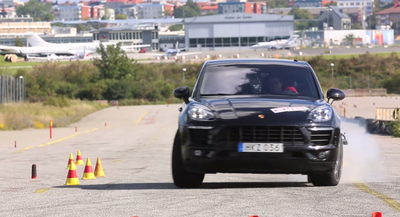Porsche Has Issued A Response About The Macan Moose Test 'Failure'
When Swedish magazine Teknikens Varld put a Macan S diesel through the ‘moose test’ - which sees how a vehicle will respond when swerving to avoid a suddenly-appearing obstacle - it didn’t behave quite how the testers anticipated. The front-left brake locked up, causing the Macan to go briefly straight on, and strike the outermost cone laid out on the test track.

The testers found this worrisome, as it suggests during an avoidance manoeuvre like this in the real world, the car could be left on the wrong side of the road for a longer period of time, putting its occupants at risk.
However, Porsche has since responded, saying that the braking action is part of its ‘Active Rollover Prevention’ (ARP) safety feature. This is intended to quell unwanted oversteer or the possibility of a rollover, something seen as more important than taking the avoidance manoeuvre a little tighter. The statement Porsche issued said: “what is more critical in this situation is if the vehicle were to roll over or the rear were to break away.”
Sounds like a reasonable enough explanation, and in any case, a little brake locking is nothing compared to how the 2012 Jeep Grand Cherokee performed in another of Teknikens Värld’s tests….
Porsche’s full statement can be read below.
The brake intervention shown in the video is a deliberately applied intervention to prevent the car from rolling over. This is called Active Rollover Prevention (ARP). The precise, momentary application of brake force to the front wheel at the outside of the bend down to the low slip range minimises cornering forces to avoid critical or instable driving conditions such as oversteer, rollover or detachment of the tyre from the wheel. Situations such as these may not be controllable by the driver.
The video shows that an understeer response is selected on purpose since it is significantly easier for the driver to control than oversteer. The function shown and the resulting driving response are explicitly desired to increase driving safety in such a highly dynamic driving manoeuvre.
In the SUV segment, Active Rollover Prevention (ARP) is state-of-the-art technology and is also used by other vehicle manufacturers.
The intensity of ARP intervention is dependent on vehicle speed and steering angle speed, among others. This means that ARP brake intervention is diminished accordingly at reduced vehicle speed or steering angle speeds. On the other hand, it means that the driving style adopted by Teknikens Värld was very demanding and resulted in the safety function being triggered.
Active Rollover Prevention is permanently active, irrespective of whether Porsche Stability Management (PSM) is on or off. If PSM is on, ARP intervention is significantly diminished since PSM brake interventions to stabilise the vehicle occur much earlier or are superimposed.
The function (ARP) is applied for a maximum of 300 milliseconds, depending on the driving situation. This short intervention ensures the directional stability of the vehicle. Lateral displacement is negligible. For this reason we do not regard this driving state as critical. As the video shows, lane changing can be completed stably and safely. What is more critical in this situation is if the vehicle were to roll over or the rear were to break away. The vehicle demonstrated none of these instable states (rollover, oversteer, wheel lift) at any time.
Porsche uses a comprehensive dynamics test programme which the Macan completed successfully. The driving manoeuvres performed include double lane change according to ISO, slalom with 10 x 18 metres and 10 x 36 metres, the VDA obstacle avoidance test which is very similar to the Teknikens Värld ”moose test”, and the NHTSA rollover safety test. All Porsche cars are designed for maximum safety based on these and other world-wide tests.
Hermann-Josef Stappen, Porsche














Comments
No comments found.